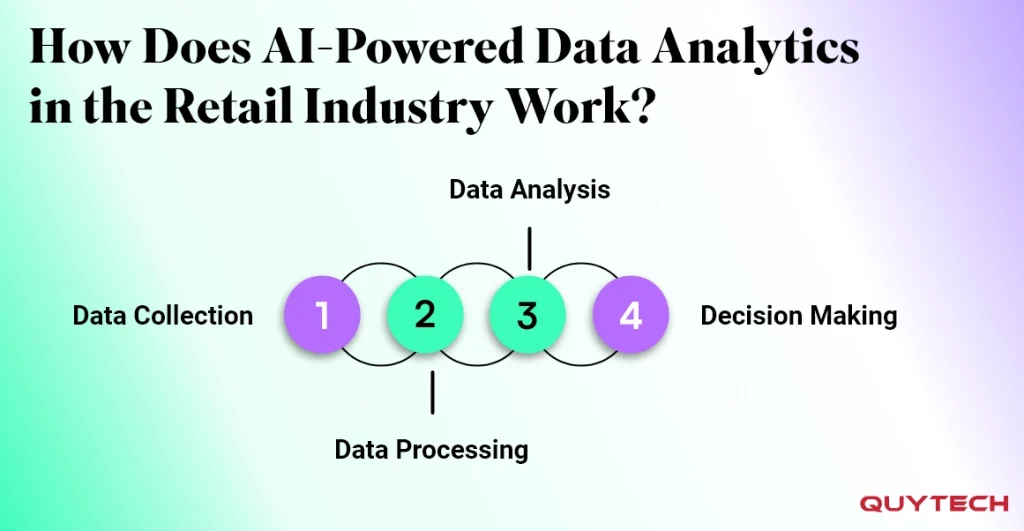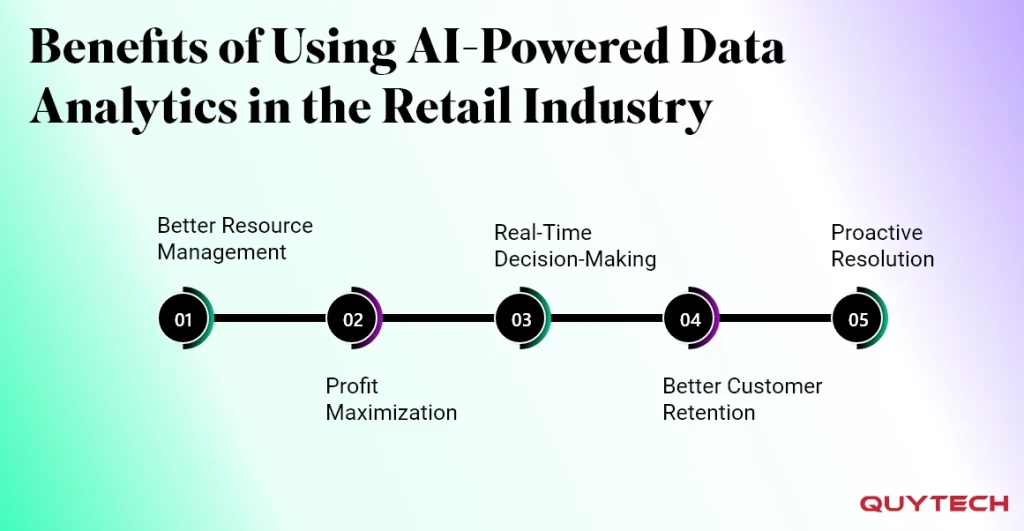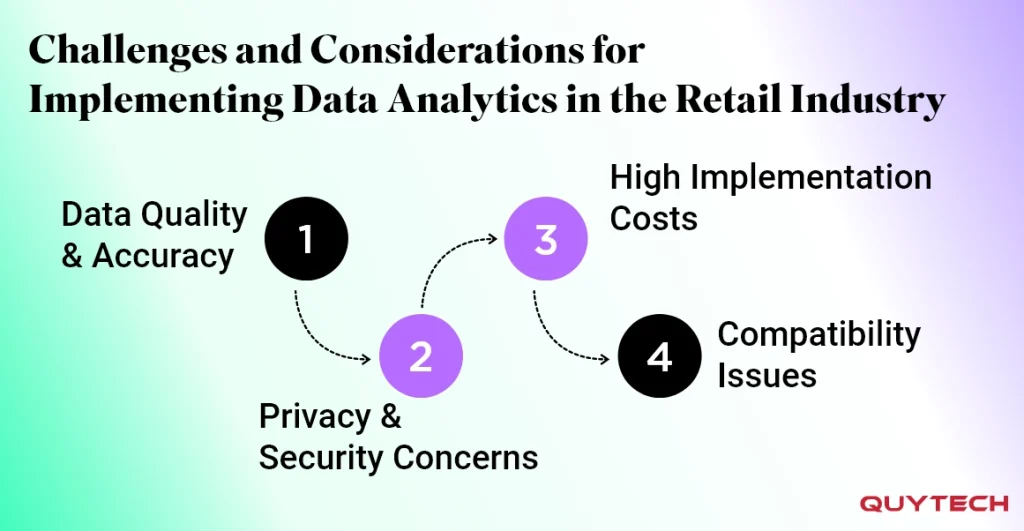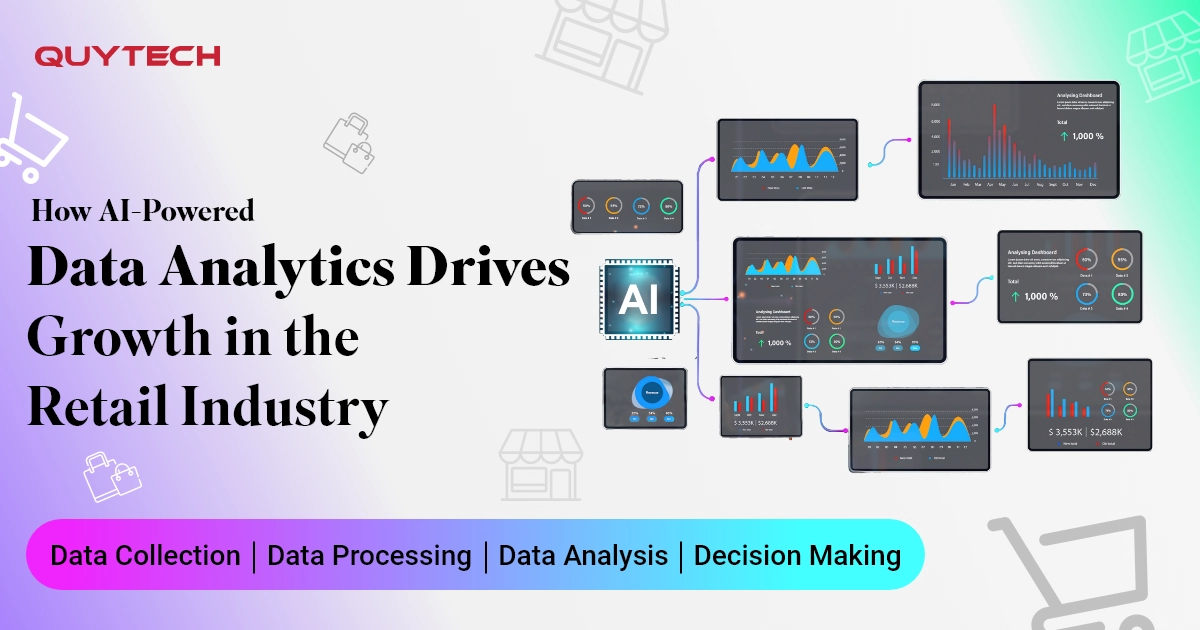Imagine understanding your customer so well that you know exactly what they need. Sounds interesting, right? Now stop imagining because AI-powered data analytics is here to bring this vision to reality.
Unlike traditional analysis, which considered only structured data to analyze customer preferences and demands, AI-powered analytics goes beyond structured data. It analyzes everything from historical data and structured data to unstructured and real-time data. And, it does not stop just here; there’s more to it.
In this blog, we have covered everything from the basics to the advances of AI-powered data analytics in the retail industry. So keep reading and find answers to all your curiosities.
Key Takeaways:
- AI-powered analytics helps in converting customer data into actionable insights.
- It does so with the help of descriptive, diagnostic, predictive, and prescriptive analytics.
- Data analytics works by collecting, processing, and analyzing data for informed decision-making.
- It boosts profits, enhances customer retention, and enables real-time decisions in the retail industry.
- In retail, it drives growth through customer insights, inventory, pricing, and fraud prevention.
- Its implementation includes data, cost, privacy, and system integration challenges.
What is AI-Powered Data Analytics in the Retail Industry?
In the retail industry, large amounts of data are generated regularly, which, when analyzed, can help businesses improve their performance. And to facilitate this, AI-powered data analysis comes into play. It collects data, analyzes it, and derives meaningful insights. But how does AI-based data analytics do all that?
AI-based data analytics makes use of varied sources from which it gathers the data. The core technologies it uses to carry this out include IoT devices. The data gathered is often in an unstructured format, which is processed using natural language processing. Once processed, the data is analyzed, and insights are generated. These insights are utilized by professionals to make informed decisions.
To carry out the above steps, AI-driven data analytics encompasses various analysis methods. They help break down what happened, why it happened, what will happen, and how to address it by analyzing data. This is done with the help of descriptive, diagnostic, predictive, and prescriptive analytics. Here’s how:
Descriptive Analytics
As the name suggests, descriptive analytics is the type of analysis that describes the event. It does so by analyzing the data. Descriptive analytics is limited to explaining the event that occurred. It operates on historical data for analysis.
Diagnostics Analytics
Diagnostic analytics goes a step further; it explains the cause of the event that occurred. Diagnostic analytics analyzes the data to derive the reason and also highlights the correlation of the data. Similar to descriptive analytics, diagnostic analytics also analyzes historical data.
Predictive Analytics
Predictive analytics, as obvious by the name, predicts what can happen. Now, unlike descriptive and diagnostic analytics, predictive analytics is not limited to only historical data. It analyzes the real-time data as well. With historical data, it can understand what patterns led to a certain event, and with real-time data, it can predict if a certain event will take place in the future.
Prescriptive Analytics
Prescriptive analytics goes above and beyond predicting future outcomes. It analyzes data patterns, takes the outcome given by predictive analytics into consideration, and offers insights. These insights provide businesses with recommendations that they can utilize to enhance their performance and be equipped to face the predicted event.
How Does AI-Powered Data Analytics in the Retail Industry Work?
Now that you are familiar with what AI in data analytics does in the retail industry, let’s walk you through its working mechanism. Here are the steps that break down how AI-powered data analytics in the retail industry works:

Step 1: Data Collection
In the initial step, data is collected from various sources. In retail, these sources are E-commerce websites, loyalty programs, applications, IoT devices, etc. This collected data comprises most of the customer usage information, like their wishlists, purchase history, shopping carts, etc.
Step 2: Data Processing
Since the data collected is from different sources, it’s only natural that it is of different types as well. It can be structured and unstructured. For analyzing this data, it will be processed first to make the analysis process less time-consuming.
Step 3: Data Analysis
After the data is processed, the process of analysis begins. Here, the data processed will be assessed to depict patterns, trends, and derive insights. Data analysis will describe the event, its reason, predict future outcomes, and suggest actions as well. AI makes these insights understandable with the help of natural language processing.
Step 4: Decision Making
Once the data is analyzed, the next step is decision-making. The insights derived will be presented on AI-powered dashboards for decision makers. This will aid easy interpretation, as the raw outcome of the analysis is not easy to understand for non-technical professionals. With the help of those insights, management will be able to make data-backed decisions.
Read More: AI Agents in Retail Industry: Top Use Cases, Benefits & Future
Benefits of Using AI-Powered Data Analytics in the Retail Industry
Data analysis in the retail industry brings in benefits that go beyond decision assistance. It benefits the retail businesses by improving resource management strategies, knowing their customers better, and much more. The following pointers will guide you through the benefits of using AI-powered data analytics in the retail industry:

Better Resource Management
AI-powered data analytics benefits businesses by improving resource management. It helps in identifying the trends and products that have good demand. This allows businesses to focus on products with high demand better and allocate their resources accordingly.
Profit Maximization
With the help of data analytics in the retail industry, businesses can maximize their revenue. This is done by analyzing the customer data, historical sales data, and real-time information.
Through this, businesses can understand the best-selling products, seasonal demand, fluctuations, and preferences of the buyers. They can set prices and launch promotion offers, etc, to maximize profit generation.
Real-Time Decision-Making
Data analysis aids businesses in making decisions in real-time. It does so by leveraging AI, IoT devices, and machine learning. These advanced technologies help in carrying out data analysis faster.
They reduce the time spent on manual calculations and making decisions in real-time. This helps businesses in the retail sector in making the right decisions at the right time.
Better Customer Retention
When data is analyzed and customers are provided with a personalized experience, it helps businesses connect with customers on an emotional level. Through this, customers feel seen and valued. This increases brand loyalty among the customers and helps in better retention.
Proactive Resolution
With the help of predictive analytics and IoT devices, businesses can proactively predict stockouts, which helps in proactively placing orders for clearing products. Apart from this, AI-powered analytics also helps in dealing with delayed delivery and customer queries in real-time.
Similar Read: Generative AI in Retail : Use Cases and Its Solutions
Top Use Cases of Data Analytics in the Retail Industry
AI-powered data analytics is utilized differently in every industry. In retail, it plays its role by following a customer-focused approach. The following are the top use cases of AI-powered data analytics in the retail industry:
Customer Analysis
AI-powered data analytics helps in understanding customer behavior. This is done by analyzing the interactions that users have with applications, websites, stores, etc. Conducting customer sentiment analysis helps businesses familiarize themselves with the trends and preferences of customers. AI-powered data analytics in the retail industry also contributes to preventing customer churn.
Inventory Management
Data analysis is capable of deriving demand trends and patterns through data. This helps businesses in maintaining optimal inventory levels. Data analysis in the retail industry ensures that the inventory is neither overstocked nor understocked, maintaining a perfect stock balance and reducing wastage.
Personalization for Customers
Data analytics in the retail industry helps businesses identify their customers better. This helps in providing a personalized experience for the customers. It is done by analyzing the data of the customers through applications, store records, sentiment analysis, etc., understanding customer behavior, and adapting to it.
Building/Designing Pricing Strategies
As already mentioned, data analytics in the retail industry is capable of predicting future demands. It helps businesses in forming pricing strategies based on demand. In case of high demand, businesses can opt for higher pricing, while in low demand, businesses can offer discounts or lower their prices to withstand the market.
Marketing Strategies & Campaign Optimization
AI-powered analytics helps businesses in the retail industry in measuring the effectiveness of their marketing strategies. It assists in optimizing the campaign by improving the message delivery, enhancing engagement, and precisely targeting the right audience.
Fraud Detection & Loss Prevention
AI-powered data analytics helps businesses in detecting fraudulent activities like bulk ordering from a fresh account and theft. It analyzes the purchase patterns and detects these anomalies. This helps prevent loss to the business by cross-verifying these purchases.
You Might Also Like: AI Video Analytics for Retail: Enhancing Retail Store Analytics
Challenges and Considerations for Implementing Data Analytics in the Retail Industry
Implementing AI-powered data analytics in the retail industry comes with its fair share of challenges. But worry not, as these challenges can be dealt with by complying with certain considerations. To make this implementation process easy, we have listed the challenges and considerations for implementing data analytics in the retail industry for you:

Data Quality and Accuracy
As you are already aware, data analysis requires data to work. The poor, inadequate, and inaccurate data become challenging when analyzed. Inadequate data often gives subpar results, poor quality data makes the process of analysis slow, and inaccurate data can lead to biased and inaccurate outcomes.
To ensure that your business does not face these data challenges, ensure that there is an adequate amount of data for analysis. The quality plays an important role, which can be achieved by following data management practices.
Privacy and Security Concerns
Since data analytics utilizes customer data for insight generation, customers might feel skeptical about their personal usage data being used. Along with this, businesses also get exposed to the risks of cyberattacks. This can lead to sensitive data being accessed by unauthorized third parties.
Businesses can prevent data privacy challenges by complying with data regulations. Along with this, following data encryption practices also adds to data protection.
High Implementation Costs
A very prominent challenge that makes businesses in the retail industry hesitate from upgrading their traditional analysis systems is the high implementation costs. The initial investment in upgrading to AI-powered data analytics can be very expensive. This makes businesses take a step back from investing in data analytics.
Businesses should understand that although the initial investment is quite high, it brings in a good return in the long run. This return justifies the investment and also helps businesses gain a competitive edge.
Compatibility Issues
Many businesses might not be equipped with the latest technology, which might impact the implementation process. It can be hard to integrate the sophisticated analytics tools with outdated systems.
However, it can be addressed by utilizing APIs for easy integration of AI-powered data analytics tools with the existing systems. Businesses can also opt for cloud-based analytics solutions.
Read More: Data Analytics For Insurance: A New Era of AI Revolution
Real-World Examples of Data Analytics in the Retail Industry
Context without examples is like a ship sailing without a compass; so here are some real-world examples of AI-powered data analytics in the retail industry:
Walmart
- Walmart makes use of data analytics to process large amounts of data for inventory optimization and management.
- Along with this, Walmart also forms pricing strategies based on insights received from data analysis.
Target
- Target utilizes AI-powered data analytics to predict customer needs. It does so by analyzing their purchase data.
- Target uses insights generated from data analysis for launching marketing campaigns. It provides personalized product recommendations to customers with the help of AI-powered analytics.
Sephora
- Sephora makes use of customers’ data, like their skin tone, skin type, product preferences, etc, from their purchase history.
- With AI and machine learning, it provides purchase recommendations. Along with this, it also suggests combo offers and products during in-store visits.
Starbucks
- Starbucks utilizes AI-powered data analytics to collect customer data to understand their preferences. This makes customers feel valued and contributes to better retention.
- With data analysis, Starbucks suggests loyalty programs, drink recommendations, and offers promotions to its customers.
You Might Also Like: How To Develop AI Solutions For Retail Industry?
How Quytech Empowers Retail Businesses with Data-Driven Intelligence
Quytech helps retail businesses understand their customers better by analyzing their data. We have over 14 years of experience in developing customized data analytics solutions for different industry verticals. This reflects our dedication to delivering both expertise and knowledge to help your business thrive.
Our team of qualified developers closely communicates to create what your retail business needs. We specialize in building solutions that align with your business. With quality and customer satisfaction at our core, we strive to deliver solutions that consistently exceed your expectations. Our successful projects in the retail sector, such as NGK, Cordero Vine, and Shoparty, reflect our ability to deliver high-quality solutions.
Conclusion
AI-powered data analytics contributes tremendously to the retail industry. In the traditional setting, customer preferences were manually assessed, dominated by intuitions. This often resulted in inefficiencies and negatively impacted customer satisfaction. But with AI-powered data analytics, everything from demand predictions to product recommendations is backed by data.
Data analytics in the retail industry brings efficiency in resource management, decision-making, and customer retention. With the rapid evolution taking place in the retail industry, switching to AI-powered analytics is no longer a trend; it’s a necessity for gaining a competitive edge in the dynamic marketplace.
FAQs
- Can AI-powered analytics help with customer retention?
Yes, AI-powered analytics can help with customer retention. It helps retailers send personalized offers and recommendations for retaining customers.
- What are two ways that data analytics benefit retail businesses?
Data analytics benefits retail businesses by enhancing decision-making processes. Also, it benefits businesses to improve their inventory management strategies.
- How does using AI-powered data analytics make it possible for retail businesses to target their advertising?
AI-powered data analytics helps retail businesses with advertising by analyzing customer behavior and understanding their preferences to deliver personalized ads for the target audience.
- How can retail businesses use AI data analytics for customer segmentation in the retail industry?
Retail businesses can use AI data analytics for customer segmentation by segregating their audience based on their spending habits, interests, etc. This helps in creating marketing strategies based on the target audience.
CTA
Turn Every Piece of Data into Revenue-Boosting Strategies
Use AI-powered analytics to transform retail data into actionable insights that maximize profits.
Get Started!
Predict Customer Behavior and Stay Ahead in the Retail Game
Leverage AI-powered analytics to anticipate trends, improve inventory, and enhance loyalty.
Upgrade Now!
Deliver Personalized Shopping Experiences That Customers Love
Utilize data analytics to decode customer preferences and create experiences that boost retention.
Drive Growth Now!


